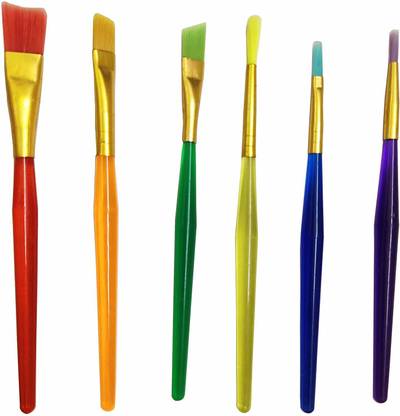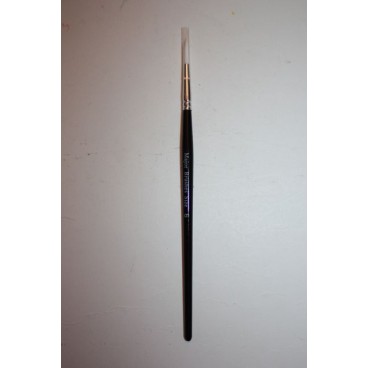Load a #6 Filbert brush into a dark green of your choice. Spend time on the palette, ensuring the brush is fully loaded while maintaining sharp chisel edges. Swipe the rounded corner on the right side of the brush into a lighter green. Pat the brush down on the palette to. One feature of paint brushes is the wide variety of sizes. Generally, the size of a paint brush can be identified by a number, the larger the number the bigger the size. Size ‘0’ is a very small brush and the sizes go up to at least size ’40’. There are some exceptions to this sizing method.
As we all know, brushes come in a variety of materials, shapes, and sizes.Most brushes have a handle, a ferrule (the object holding the bristles), andbristles made of synthetic or natural materials.The bristles have a length (measured from the ferrule to the tip) and a width(measured where the bristles exit the ferrule),but what's the brush number?This article describes the brush size numbering system that oftenappears on the handle of paint brushes.Basically, the numbering system is meant to order the sizes of brushes.The system begins at 0. Larger brushes are signified by increasing wholenumber values. Smaller brushes are signified by increasing the number ofzeros. The smaller sizes are often abbreviated with a slash notationending in '/0' and having a whole number for the number of zeros.Hence, the following two ordered ranges are equivalent:
| Size | Round Size | Flat/Other Size |
|---|---|---|
| 5/0 | <<1/64' | <<1/64' |
| 4/0 | <1/64' | <1/64' |
| 3/0 | 1/64' | 1/64' |
| 2/0 | <1/32' | <1/32' |
| 0 | 1/32' | 1/32' |
| 1 | 3/64' 2.7mm | 2/32' 5.3mm |
| 2 | 2/32' 3.1mm | 3/32' 6mm |
| 3 | 5/64' 4.2mm | 4/32' 6.5mm |
| 4 | 3/32' 5.5mm | 5/32' 9.2mm |
| 5 | 7/64' 6.3mm | 11/64' 10.1mm |
| 6 | 4/32' 7mm | 6/32' 11mm |
Some better suppliers perform their own brush size measurements.Blick Art Materials has somegreat reading material on brush sizes, shapes, and materials at:
Most miniature painters use a variety of brushes.The size of the brush generally determines how much paint you can loadand carry to your miniature, and how much paint is applied tothe miniature - the width and rate of paint application.For 15 and 28 mm miniatures, the brush sizes 000 through 2 are mostlikely the sizes you will use, with perhaps one or two other sizes forpriming and dry brushing and top coating.Be aware that the brush size notation is arcane and inconsistentfrom manufacturer to manufacturer.
More miniatures-related articles are atDan Becker's Miniatures and Models site.Thanks for stopping by and reading about my miniatures.
Last modified: Sunday, 28-Apr-2019 13:49:29 MST.
Want to learn new Filbert Brush techniques? Check out the tutorial videos on this page.
What I like about the Filbert brush is the variety of waysit can be used. Part of the Flat brushfamily, the filbert has a rounded chisel edge.
It comes in many sizes which makes it great no matter what project you're working on!
The brush performs well from basecoating, to floating or forcreating shapes like leaves and petals. It also does lovely strokework.
Let's See How The Filbert Brush Performs
When it comes to basecoating a round shape, nothing beatsthe Filbert Brush. The rounded edges of thebrush prevent ridges from forming. Italso performs great for straight edges.
Like all brushes, moisten the brush first in cold water andthen blot the excess on a paper towel. Load the paint on the brush taking time to blend the paint evenly intothe bristles by sweeping the hairs on the wax palette.
Free tunes download. Take the time to make sure the paint is evenly distributedon both sides of the brush. If you havetoo much paint, wipe some off on another spot on your palette. If you have too much water in the brush,blot it on the paper towel.
Shading and Highlighting
The shape of the Filbert makes floating color on roundshapes a breeze! Dress the brush as youwould a Flat.
First wet the brush andblot it a little on the paper towel. Side-load the rounded edge of the brush into the paint and blend on thewax palette, ensuring the paint gradually fades before reaching the other sideof the brush.
Float the color by pulling in a patting motion. A long uninterrupted float is not aseffective as pulling and patting.
Double-Loading
If you want to double load the Filbert, simply load thebrush with one color, blending it well on the palette. Then side-load into a second color, blendingit on the palette so as to gradually merge the second color into the maincolor. A sort of soft, blendedappearance is what you're after.
Applying Thin Washes
My experience is that applying washes of color with theFilbert reduces or eliminates brush marks.
Mix an inky consistency paint puddle. About 80% water 20% paint. Sort of like skim milk.
Place the damp brush in the wash, blot verybriefly on paper towel and the apply the wash to your project. If you're pushing too much paint around,quickly blot on the paper towel again.
Let's Have A LookAt the Filbert Brush in Action!
Scroll Down for Free Detailed Video Instructions!
Simple Leaves 1
Before we get started.. get a copy of the line drawing and print it.
First we need to decide which way the leaves are facing.
Load a #6 Filbert brush into a dark green of yourchoice. Spend time on the palette,ensuring the brush is fully loaded while maintaining sharp chisel edges. Swipe the rounded corner on the right sideof the brush into a lighter green. Patthe brush down on the palette to break the tension between the 2 colors whileblending.
If the leaf tip is facing upward, then keep the highlightcolor on the right side of the brush.
If the leaf tip points downward, then keep the highlight onthe left side of your brush.
It's not a rule, it just makes it easier for me to teachthis to you. :o)
OK, place the brush down at the base of the leaf and applypressure to help fan out the hairs. Now, depending on which way the leaf is pointing..
For the leaves whose tips are pointing to the left, pull thebrush toward the tip of the leaf while releasing the pressure, dropping theleft side of the brush down (pivoting handle counter clockwise) as you pull offon the chisel of the brush, ending on a fine point.
For the leaves whose tips are pointing to the right, pullthe brush toward the tip of the leaf while releasing the pressure, dropping theright side of the brush down (pivoting handle clockwise) as you pull off on thechisel of the brush, ending on a fine point.
Simple Leaves Tutorial Video 1
Simple Leaves Tutorial Video 2
Simple Leaves Video 2 - This one builds on the lesson in Video 1
These are done the same way as the Simple Leaves 1, exceptyou're butting two strokes against each other, slightly overlapping the firststroke. You'll need the line drawing for this tutorial. If you don't have it yet, you can download it here.
3-Stroke English Ivy Leaves Tutorial Video 3
6 Inch Paint Brush
3-Stroke English Ivy Leaves
Here we simply use 3 strokes to build one leaf. First the sides of the leaf and then themiddle.
Number 6 Paint Brush
Painting A Daisy Tutorial Video 4
Let's Try a Daisy!! - Video coming soon..
Use a #6 Filbert to basecoat the daisycenter with Marigold. While this is drying, add petals of Shale Green. Simply apply pressure at the tip of the petal and then release the pressure as you pull the stroke toward the flower center.
Add another coat of Marigold to the flower center.
Dry brush Warm White over the petals. Use the Filbert and load it into the paint then wipe off both sides of the brush on dry paper towel. Position the crescent shape of the brush at the tip and lightly drag the brush down to the base of each petal.
Use the Filbert to float a highlight at the top of the flower center with French Vanilla.
Shade the bottom of the flower center and the divot in the center with Milk Chocolate.
When dry, float a highlight behind the divot shade using French Vanilla.
Further dry brush more Warm White over each petal until you have nice white petals.
Use a stylus to add dots of Midnite Green and French Vanilla to the flower center.
Stay tuned as I keep adding more and more information on various specialty brushes. Let's leave the filbert brush page and go to the Home page!

You Can Paint These Trees and More
Get Your Video Course Now

Introductory Price
Save 55% plus
a Money Back Guarantee
1 Paint Brushes
Click Here Treat Me To A Coffee
What Size Is A Number 6 Paint Brush
New! Comments
Have your say about what you just read! Leave me a comment in the box below.